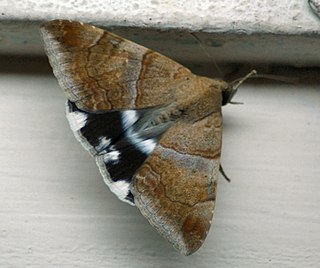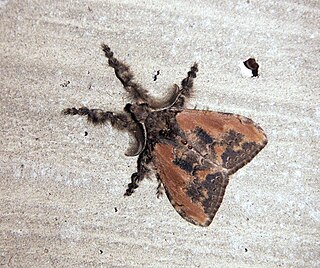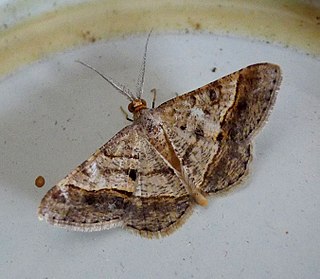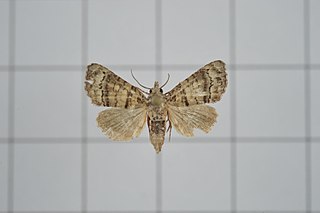
Achaea janata, the castor semi-looper or croton caterpillar, is an erebid moth, the caterpillars of which are termed 'semi-loopers' due to their mode of locomotion. It is found from the Indo-Australian tropics and subtropics, extending south to New Zealand and east through the Pacific archipelagoes to Easter Island. It is a major pest of castor throughout the world.

Olene mendosa, the brown tussock moth or hairy tussock moth, is a species of moth in the family Erebidae. The species was first described by Jacob Hübner in 1823. It is found in India, Bangladesh, Sri Lanka, Indonesia, Taiwan, Thailand and Australia.

Nepita is a monotypic moth genus in the subfamily Arctiinae erected by Frederic Moore in 1860. Its only species, Nepita conferta, the footman moth, was first described by Francis Walker in 1854. It is found in India and Sri Lanka.

Achaea serva is a species of noctuid moth of the family Erebidae first described by Johan Christian Fabricius in 1775. It is found from the Indo-Australian tropics of India, Sri Lanka, Myanmar, China, Borneo, Hong Kong, Java, the Philippines, the New Hebrides, to Okinawa, many western Micronesian islands and New Guinea and Australia.

Cryptophlebia ombrodelta, the litchi fruit moth or macadamia nut borer, is a moth of the family Tortricidae. The species was first described by Oswald Bertram Lower in 1898. It is native to India, Sri Lanka, Nepal, Indonesia, China, Taiwan, Vietnam, Thailand, western Malaysia, New Guinea, the Philippines, Japan, Guam, the Caroline Islands, Australia and has been introduced to Hawaii.

Biston suppressaria, the tea looper, is a moth of the family Geometridae. It is found in China, India, Myanmar, Nepal, and Sri Lanka.

Metanastria hyrtaca, called the hairy caterpillar as a larva, is a moth of the family Lasiocampidae first described by Pieter Cramer in 1782. It is found in Sri Lanka.
Dasychira thwaitesi is a moth of the family Erebidae first described by Frederic Moore in 1883. It is found in India and Sri Lanka.
Psalis pennatula, the yellow hairy caterpillar, is a moth of the family Erebidae. The species was first described by Johan Christian Fabricius in 1793. It is found in India, Sri Lanka, Thailand, Australia and Java.

Comibaena cassidara is a moth of the family Geometridae first described by Achille Guenée in 1857. It is found in Sri Lanka, India, Nepal, Pakistan, China, Thailand, Philippines, Malaysia, Singapore and Borneo.

Isturgia pulinda is a moth of the family Geometridae first described by Francis Walker in 1860. The species has a widespread distribution from the African countries of Botswana, Ethiopia, the Gambia, Kenya, Malawi, Mozambique, South Africa, Tanzania, Zambia and Zimbabwe to Saudi Arabia and Yemen towards the Indian subregion and Sri Lanka. In Europe, it is found in the Canary Islands, Spain, Portugal and the Cape Verde Islands.

Chlumetia transversa, the mango shoot borer, is a moth of the family Euteliidae. The species was first described by Francis Walker in 1863. It is a widely distributed across Indo-Australian tropical countries far east to Solomon Islands.
Macroplectra nararia, the coconut slug caterpillar, is a moth of the family Limacodidae. The species was first described by Frederic Moore in 1859. It is found in Sri Lanka and India.
Eumeta variegata, commonly known as the paulownia bagworm or cotton bag worm, is a moth of the family Psychidae. The species was first described by Snellen in 1879. It is found in Japan, Papua New Guinea, India, the Solomon Islands and Sri Lanka.

Pteroma plagiophleps is a moth of the family Psychidae first described by George Hampson in 1892. It is found in India, Bangladesh, Sri Lanka, and Indonesia.

Maceda mansueta is a moth of the family Nolidae first described by Francis Walker in 1857. It is found in Japan, Sri Lanka, Borneo, India (Andamans), Malaysia, New Guinea, Fiji, Australia, Réunion and the Seychelles.

Xanthodes transversa, the transverse moth or hibiscus caterpillar, is a moth of the family Nolidae. The species was first described by Achille Guenée in 1852. It is found in India, Sri Lanka, the Andaman Islands, the Nicobar Islands, China, Hong Kong, Vanuatu, Java, New Guinea, Japan, the Ryukyu Islands, Singapore, Indonesia and Australia.
Selepa discigera is a moth of the family Nolidae first described by Francis Walker in 1864. It is found in Oriental tropics of India, Sri Lanka, New Guinea and Australia.
Selepa plumbeata is a moth of the family Nolidae first described by George Hampson in 1912. It is found in Oriental tropics of India, Sri Lanka, and Borneo.

Earias cupreoviridis, called the cupreous bollworm as a larva, is a moth of the family Nolidae. The species was first described by Francis Walker in 1862. It is found in African countries like Botswana, the Democratic Republic of the Congo, Eritrea, Ethiopia, the Gambia, Kenya, Nigeria, Sierra Leone, South Africa, Togo, Uganda, Zimbabwe to Asian countries like India, Sri Lanka, China, Japan, Korea, Philippines, Indonesia and Hong Kong.












